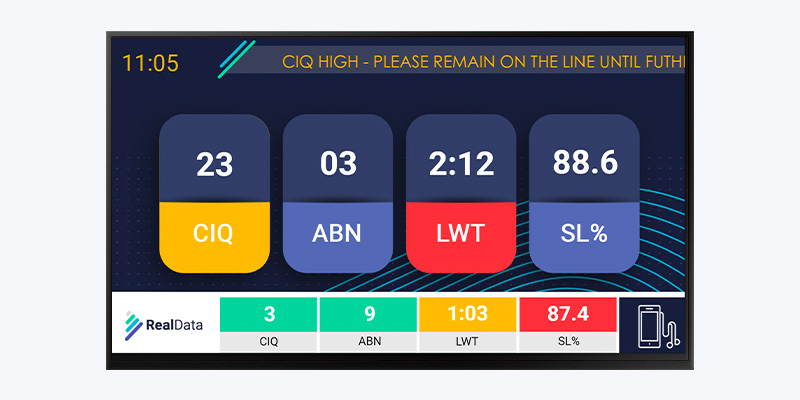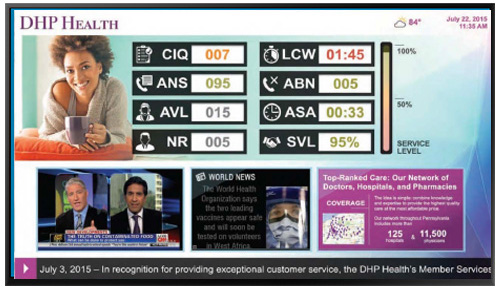The typical computer chip that drives today’s digital devices is 10 nanometers in size. Some are as small as 2. What’s a nanometer? Just one-billionth of a meter. For a sense of scale, a sheet of paper is 100,000 nanometers thick.
How is it that something so minuscule in size is both so powerful — and at the same time able to upend entire industries and communication channels? Right now, a global chip shortage is holding back the production of the screens that are the essence of digital signage solutions — and are in many ways the lifeblood of business. This is also simultaneously derailing countless opportunities for businesses like yours to use those displays in transformative ways, to engage and interact with customers, students, audiences and employees.

“Digital signage” is a concept that covers all the screens that communicate with these groups on your behalf. Wall displays at reception areas, a kiosk in shopping malls, wallboards in contact centers — even the individual monitors used by the individuals in your workforce. With the right combination of hardware and a workplace experience platform, these screens can inform in animated, targeted ways that elevate your message — and even orchestrate behaviors based on set timing or triggered actions.

That’s the potential, anyway. But for many businesses right now, the global chip shortage has curtailed their plans to implement or expand digital signage in banks, offices, schools, warehouses, contact centers, hospitals, retail outlets and more. Those monitors have gone missing — or, technically, may have never made it to manufacture, because they lack the integrated circuit chips that transform them from dumb glass into smart additions to your business.
The signal processors, switchers, adapters and converters that are part of a digital signage system are both inside and external to any monitor. Wherever they’re located, they are the glue that connects the video, audio, control, networking and single system management together. And each of those have their own chips that are part of this happy audiovisual family. Without the chips, the AV solution perfect for your business can’t be built.
No glue, no view.
What Happened to the Semiconductor Chips in the Supply Chain?
The pandemic began with the indignity of toilet paper shortages. 21 months in, the latest consequence is a lack of the silicon that is impacting virtually anything with a screen. No doubt you’ve heard the supply chain is to blame. But what exactly does that even mean?
In regard to the display supply chain, the missing ingredient is semiconductors. Specifically, the display drivers that send digital signs instructions for illuminating the screen. A perfect sequence of events has impacted just about anything with a screen. Or, in terms of consequences, the more accurate description is “imperfect.”
In the early days of COVID, chip production looked at jobless rates and anticipated an economic slowdown. Consequently, they expected demand for their technology would remain low, and reduced their orders for semiconductors. But “unprecedented times” came with an unanticipated sequence of events.
The migration of workers out of office fueled a tech buying spree. The advent and then surge of hybrid and work-at-home Zoom meetings increased the purchase of all things dependent on chips: digital displays, desktops, laptops, webcams, monitors. As the economy then rebounded, people added “buy now” to yet other consumer electronics items fueled by chips — straining the supply shortage even more.
And just for good measure: throw in a winter storm that shut down key Texas semiconductor industry; a fire in Japan that caused similar delays; a big increase in the cost of moving shipping containers and air freight; plus, a lorry driver shortage in Europe.
On the Wrong End of the Supply Chain Whip
This serious imbalance in supply and demand is an economic phenomenon known as the “bullwhip effect.” Think of when a cowboy cracks a bullwhip. The hand might move just a few inches. But the ripple down the length of the leather grows larger until the tip snaps several feet through the air. The same applies when small shifts in demand ripple up the supply chain, resulting in more extreme swings in production.
Retailers can only guess at the future, so they introduce error when they scale orders against expected demand. Wholesalers enlarge that error when they shift their orders to manufacturers, who exacerbate the effect when they request raw materials from their suppliers. The further up the supply chain, the more the demand distorts.
Watch out for that bullwhip! CRACK! That’s the sound of the semiconductor supply chain.
Eager to ramp UP production, manufacturers rushed in orders for more semiconductors. That surge hit suppliers like Qualcomm, NVIDIA and Huawei who design and sell chips. In turn they expanded their orders to suppliers like Samsung, TSMC and Intel, with their foundries for assembling advanced semiconductors. That crush of orders then overwhelmed the companies that supply basic parts.
Now fully aware and in the midst of the chip shortage, every company is stockpiling chips to weather the storm. But hoarding further distorts the demand signal, bullwhipping through the supply chain to make it seem like companies require many more chips than are needed to meet demand.
What Can I Do with Digital Signage?

In a more perfect world — and better supply chain resiliency — digital signage is your chance to turn your monitors, kiosks and screens into interactive content. A modern digital sign solution is attention-getting, entertaining, informative, dynamic and immersive. It can extend across your office, campus or multiple locations — and yet be simply activated and managed through a single, easy-to-use workplace experience platform. The opportunities for personalized communication to students, faculty, visitors, customers and employees are extensive:
- Animate positive quotes from company leaders.
- Stream your social media feeds
- Project real-time wayfinding maps to guide across your campus or office
- Display live performance data and KPIs to motivate contact center and sales teams
- Poll your workforce for ideas and feedback
- Highlight new products to generate interest and sales
- Showcase customer and employee content: surveys, photos, reviews
- Spotlight achievements of individuals and teams to elevate a culture of openness and collaboration
- Announce room reservation availabilities and bookings
- Promote safety and health alerts and protocols
Imagine your screens working for you, with relevant words, images, and video that influence and activate your customers and your employees. It sounds like a memorable workplace and operation! Can it still happen considering the shortage?
It’s Going to Get Better…Right?
Eventually.
But the fact is chip shortages won’t be solved anytime soon. It’s not a matter of one or two chips and good to go. To correct the situation, chip manufacturers need all the right components.
Some projections suggest the disruption could last until next year — although it remains almost impossible to accurately forecast when it will end, and the market will totally recover. Distributors, integrators and businesses looking to implement or expand their digital signage will have to remain flexible. For many, the best course will be to order in advance, and plan accordingly for potential delays.
Watch and Wait? Or ACT and Influence?
Maybe you’re a company that can afford to defer your plans for digital signage. But it’s more likely you’ve seen your communication needs highlighting during this time: marker boards and print posters can only take your vision and your employees so far. Is there a technology alternative in spite of the global chip shortage?
Mobile platform
One possibility is to elevate your communications through a workplace experience platform that features a wider range of capabilities. This has been referenced as the driver for digital signs, but a truly modern platform will have extended reach. Through a single intelligent content management system, your professional communicators can publish relevant content to your entire workforce through messages, HD videos, alerts, and notifications sent to mobile devices. These can be targeted and personalized to engage with individuals and teams based on key criteria, such as location, role, and demographics. Active channels for engagement can include traditional email, web browser-based access to a revitalized intranet — and, perhaps most effectively, a mobile employee app with enhanced access to content, business apps, social features and two-way communication.
And when nothing but digital signage will do? Korbyt’s leadership in workplace experience solutions may provide a more immediate option. Our long-standing relationships with a global network of manufacturers and warehouses means we can often source products and exercise influence in ways that other digital signage companies can’t begin to consider. Given the situation, there may still be the need for adaptability: staggering installation times to avoid peak periods; or the available monitors might be LCD instead of LED, for example. But we’re open to a leveraging our connections on your behalf.
It can be disconcerting to think how such a small component as a computer chip can cause of so many big problems. But at the same time, the role of those chips in the expanding potential of digital signage suggests the motto of Sir Francis Drake, “Sic Parvis Magna.”
“Thus great things from small things.”









